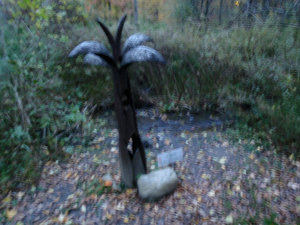Advertisement
Published: December 25th 2011

 Griffis Sculpture Park
Griffis Sculpture Park
Metal flower along the trail in Griffis Sculpture ParkMy main goal for today was to drive to Buffalo.
The interstates in western Pennsylvania are not as crowded as on the east coast, so this went much smoother.
There was still quite a bit of foliage in this part of the state.
Part of the road goes by active farms, and I certainly smelled it.
I still had some time available to see things.
The first was the
Seneca Nation of Indians.
They are the westernmost member of the famous
Iroquois Confederacy.
In their own language, their name translates as "Keepers of the Western Door".
They once occupied an area covering most of western New York State.
How and why they lost it is part of what I came here to find out.
Seneca-Iroquois National Museum
These days, far more people come to the reservation to shop and gamble than travel.
The reservation is exempt from New York State sales tax, so you can buy things much cheaper than the surrounding area, particularly gas, tobacco products, and alcohol.
New York's gas tax is over 25 cents per gallon, so the savings are significant.
It seems
that the main street is lined with nothing but stores and gas stations.
That being said, the base price of gas in this area is high, so one can do almost as well for gas by driving to Buffalo or Syracuse.
The main item of interest to travelers is the
Seneca-Iroquois National Museum.
It was established by the Nation in the last 1960s as they saw tribal artifacts being bought by collectors.
Its centerpiece is a display of the nation's history from ancient times to the present.
It contains reconstructions of dwellings over the centuries.
Part of the display describes mythology, including the story of the "Great Peace" that lead to the founding of the Iroquois Confederacy.
A section of the museum also details the Iroquois's dealings with the US government, and the one-sided treaties they had to endure over the years.
It turns out that the US history of Native American mistreatment goes back a long way (the first Iroquois treaty was signed in 1797 by George Washington!)
The museum now contains a large collection of Seneca artworks.
They are arranged to show

 Sculpture from Griffis Sculpture Park
Sculpture from Griffis Sculpture Park
This sculpture is located across from the parking lothow their development changed over time.
For instance, the beadwork now associated with Indian art did not appear until English settlers introduced glass beads as trade items.
Some artwork by current artists is available in the gift shop.
The most poignant, and bitter, section of the museum tells the story of the
Seneca's struggle against the Kinzua Dam in the late 1950s.
Since the early 1800s, the tribe has been confined to a small reservation along the Alleghany River.
The land near the river was fertile, so the Seneca could maintain some aspects of their traditional lifestyle.
The reservation was guaranteed to the tribe by a 1797 treaty that stated it could never be taken away.
The Alleghany River flooded regularly.
These floods caused havoc for towns near the river, particularly Pittsburgh.
A flood control dam was proposed in the 1930s to regulate these floods.
The Army Corps of Engineers finally started work in earnest in the early 1950s.
The site they proposed would flood the most fertile part of the Seneca's land.
The tribe refused to sell.
The Corps then moved to take it by eminent domain.

 Sculpture Trail
Sculpture Trail
In Griffis Sculpture Park, every trail reveals a new surpriseA desperate struggle developed in the courts and public opinion to stop the dam.
In the end, the tribe lost.
A federal appeals court ruled that the Government had the right to break the treaty and take the land.
The impact on tribal members was devastating, and it is thoroughly documented in the displays.
The loss forced the Seneca to modernize and find other ways of making a living.
The bigger impact was culturally, as important links to a way of life that goes back in history to before Columbus were wiped out.
Griffis Sculpture Park
After the museum, I headed to a cultural site of a very different sort,
Griffis Sculpture Park.
This Park is a private nature park.
Large pieces of modern sculpture line the trails.
Even the box for your entry fee is a sculpture.
The trail starts by passing though an old apple orchard.
It passes through a field and enters a forest, emerging by a pond.
It then climbs a hill and enters a mountain meadow with huge views of the surrounding area.
Everywhere, there are large sculptures of insects, cubes, exploded

 Major Griffis Sculpture
Major Griffis Sculpture
Tower at the top of the main fieldspheres, tree houses, and everything in between.
The combination of art and natural beauty is wonderful to look at.
The trails can be navigated in ordinary footwear, but be aware that they get muddy after rains.
Buffalo Food
After Griffis came the drive to Buffalo.
Buffalo has made several contributions to the world of cheap, meaty dining.
The most famous is
Buffalo wings, but there are many others.
I had dinner that night at
Bob and John's, which is best described as a cross between an Italian restaurant and a greasy spoon.
Its a neighborhood favorite, with everyone from kids celebrating an early Halloween party to couples in their 80s eating away.
It should go without saying that I ate a large plate of wings, with a side of potato chips, washed down with cheap Canadian beer.
It was messy, delicious, and priced right.
Advertisement
Tot: 0.095s; Tpl: 0.01s; cc: 12; qc: 29; dbt: 0.0391s; 1; m:domysql w:travelblog (10.17.0.13); sld: 1;
; mem: 1.1mb








